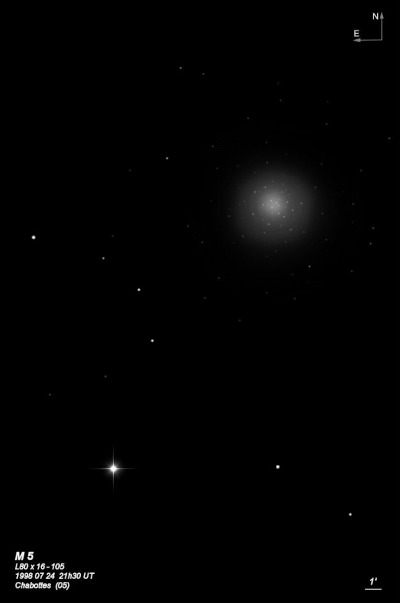
Gottfried and Maria Kirch discovered M5 = NGC 5904 = h1916 on 5 May 1702. Maria's diary (translated by Leos Ondra) mentions "By such searching [for the comet then visible] my husband found by this with just this 3 Sch. tube, high over Mu [Serpentis] a nebulous light, it had many other fine stars around it, but one stood particularly by the tube above it about thus: [sketch follows]." Charles Messier independent found it on 23 May 1764.
William Herschel's first observation using his 6.2-inch (7-ft telescope) was on 4 Mar 1783: "It consists of stars; they are however so small that I can but just perceive some, and suspect others. 1810 (power?), the globular figure is visible." Using his 18.7" on 5 May 1785 (sweep 409) he recorded, "a very compressed very beautiful, and large cluster of small stars of various sizes, and of a red colour. For about 2 or 2.5' they are extremely compressed in the center; and the pretty regularly scattered stars extend to about 7 or 8' diam." Then there are besides many more irregularly scattered at a greater distance; especially one branch, which extends in a direction of about 15 or 20 degrees sp and some of the stars of this branch are rather larger than the rest." On 24 Feb 1787, he logged "The most beautiful, extremely compressed cl of small stars; the greatest part of them gathered together into one brilliant nucleus; evidently consisting of stars, surrounded with many detached gathering stars of the same size and colour."
While being instructed by his father on his first sweep of 29 May 1821, John Herschel logged, "a most beautiful cluster, vmbM, very compressed, round, the stars various sizes scattered." The sweep was later numbered 53, out of date. His regular sweeps began in 1825.
200/250mm - 8" very high resolution of large, intense outer halo, many stars at edge of small core.
300/350mm - 13.1" spectacular resolution of several hundred stars from the outer halo to the core, rows of long streamers.
400/500mm - 17.5" (5/10/86): very bright, very large, extremely dense, edge-to-edge resolution of several hundred stars across 22' field (not possible to count), many stars arranged in arcs and streamers. Strong even concentration to a large very bright core. Third best globular cluster from northern California (5th brightest integrated magnitude) and can be glimpsed naked-eye in as a small fuzzy glow in dark skies. Located 22' NW of 5 Serpentis (∑1930 = 5.2/10.2 at 11") and the star is more prominent than the globular.
Naked-eye - (7/26/06): M5 was just visible naked-eye but the nearby mag 5 star (5 Ser) detracts from the observation. The globular appears as a faint, very small fuzzy glow close NW of the star.
(1/21/12): confirmed naked-eye from Mauna Kea visitor center though the nearby mag 5 star is much more prominent.
Notes by Steve Gottlieb